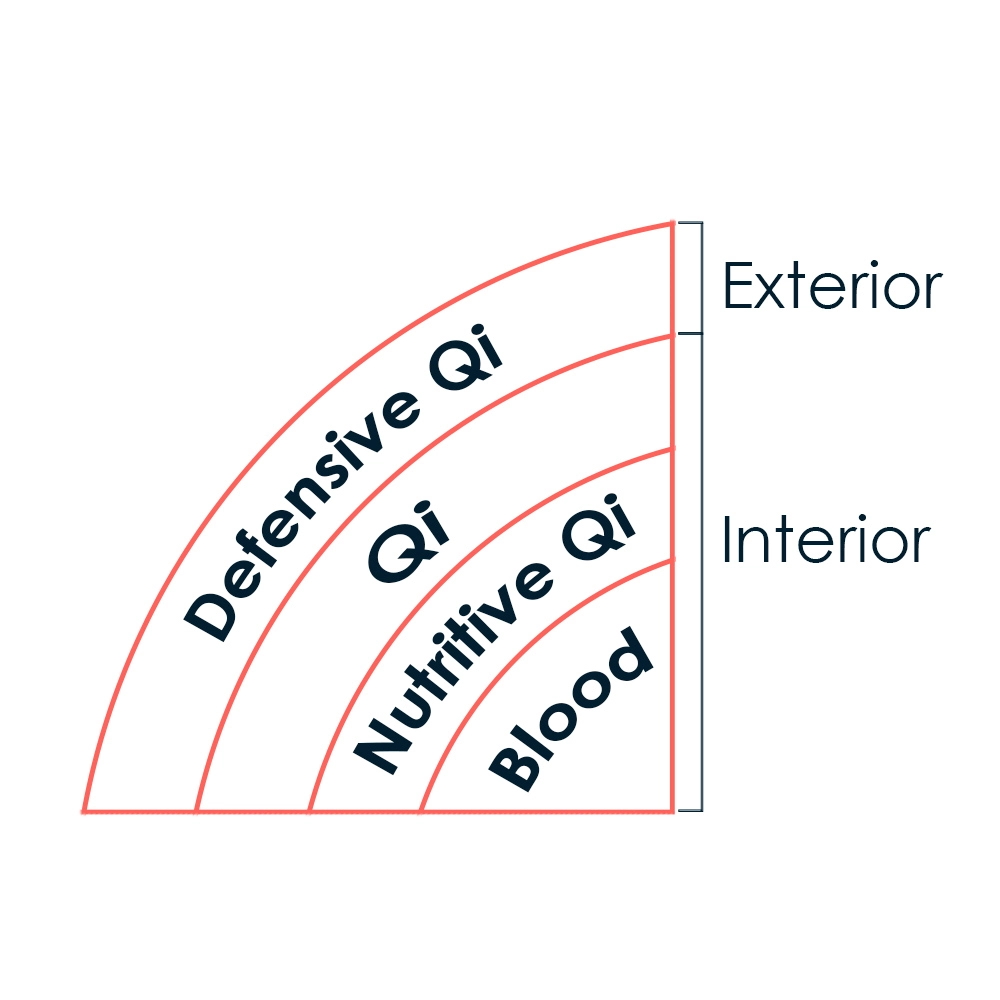
The four levels theory
Chinese: 卫气营血辨证 Pinyin: Wèi Qì Yíng Xuè Biàn Zhèng
Summary: The Four Levels theory describes the progress of infectious and feverish diseases caused by External Heat. The invasion first affects only the superficial Exterior of the body before progressively getting deeper level by level. It is widely used as a way to classify and identify patterns of disharmony so as to treat patient conditions appropriately.
The Four Levels theory was developed during the Qing Dynasty by Ye Tian Shi in his book "Discussion on Warm Diseases" (Wen Bing Lun, 1746).
While the Six Stages Theory is mostly about diagnosing and treating diseases caused by External Cold, the Four Levels describes the treatment of virulent diseases caused by External Heat.
Historically it represented a major milestone in Chinese Medicine theory. For almost 15 centuries beforehand, the thinking had been that diseases of external origin were all caused by Wind-Cold, even if they transformed into Heat internally. Introducing the concept of diseases caused by Wind-Heat was a real revolution.
To this day the theory is widely used as a diagnostic and treatment protocol for the treatment of infectious and feverish diseases.
The basic theory
The Four Levels theory deals with Warm Diseases. Such diseases share a few characteristics:
- They cause fever
- The pathogenic factor enters through the nose and mouth
- They are infectious (i.e. people to people transmission)
- The patients' condition develops rapidly
- They have a strong tendency to injure Yin
All Warm Diseases are caused by invasion of Wind-Heat but not every invasion of Wind-Heat causes a Warm Disease. They really need to have the characteristics above to be considered one.
In Western medicine terms examples include influenza, measles (rubeola or rubella), chicken pox (varicella), mononucleosis (glandular fever), mumps (parotitis), SARS, COVID-19, meningitis, encephalitis, whooping cough (pertussis) or scarlet fever.
The theory describes what happens as the invasion progresses deeper within the body, through four levels of invasion, one at the Exterior of the body and three within the body's Interior.
Let's now look at each of the four levels.
The four levels
Defensive Qi level (卫分, Wei Fen)
Generally this stage represents the early stages of febrile and infectious diseases. At this stage the disease in still in the Exterior of the body.
It comprises four different patterns according to the nature of the pathogenic factor:
Of these four, Wind-Heat is by far the most common one.
Qi level (气分, Qi Fen)
This level is similar to the Yang Ming stage in the Six Stages theory.
It is the first Interior level reached by the disease and as such the most superficial one. While the disease has progressed, this level is never life threatening.
The general symptoms at this level include high fever, thirst, a feeling of heat and mental restlessness. There are five patterns with more detailed symptoms:
- Lung Heat
- Stomach Heat
- Intestines Dry-Heat (Fire in Intestines)
- Gallbladder-Heat
- Damp-Heat in Stomach and Spleen
Nutritive Qi level (营分, Ying Fen)
This represents an acute stage of the disease that is generally better referred to Western medical treatment whenever possible.
At this level, the Heat is deeper within the body and has begun to injure the Yin and obstruct the Mind, causing delirium and even coma.
There are two patterns at the Nutritive Qi level:
Blood level (血分, Xue Fen)
This represents an acute stage of the disease that is generally better referred to Western medical treatment whenever possible.
This stage involves severe damage to Essence and Blood, so that in addition to severe high fever and coma, there are symptoms of bleeding such as epistaxis and hematuria. Macules on the skin are also a definite sign that Heat has reached the Blood level.
There are five patterns at the Blood level:
